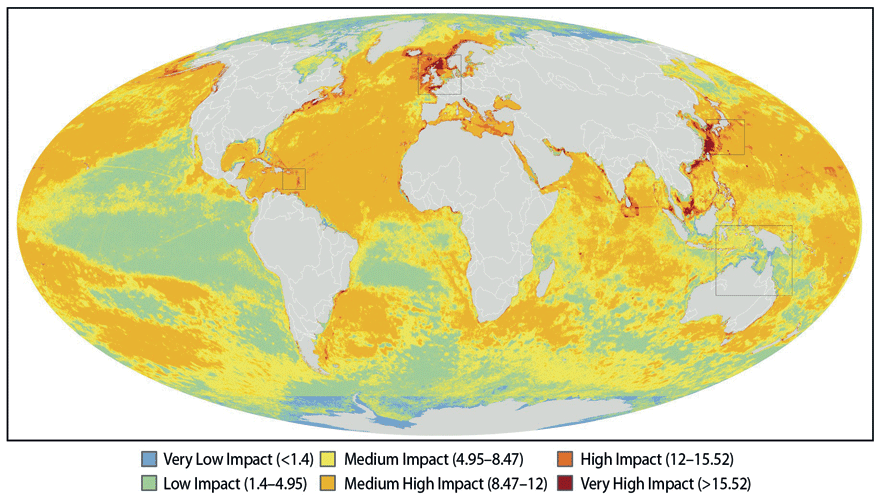
Travel
Oceans
No Pristine Oceans Left,
New Map Shows
No areas of the world’s oceans remain completely untouched by humanity’s influence, according to a new study.
By: Mason Inman *
 Every area of the oceans is feeling the effects of fishing, pollution, or human-caused global warming, the study says, and some regions are being affected by all of these factors and more.
Every area of the oceans is feeling the effects of fishing, pollution, or human-caused global warming, the study says, and some regions are being affected by all of these factors and more.
A team led by Ben Halpern of the University of California, Santa Barbara, created the first global map that shows the various kinds of damage being done to marine ecosystems.
The team assigned scores to 17 human impacts and tallied them up for every ocean region to reveal the overall effect people are having on marine life.
“The ocean is so big, I figured there would be a lot of areas that we hadn’t gotten to or that people rarely get to,” Halpern says. “But when you look at the map, there are huge areas that are being impacted by multiple human activities,” he says.
“It was certainly a surprise to me.”
The project revealed that more than 40 percent of the world’s marine ecosystems are heavily affected.
Major hot spots include the North Sea off the northern coast of Europe and Asia’s South China Sea and East China Sea.
Of all the human effects on marine ecosystems, climate change is having by far the largest overall impact, the researchers estimate. Greenhouse gases such as carbon dioxide are warming up the atmosphere and, more slowly, the oceans, the scientists explain.
Also, carbon dioxide dissolves into ocean waters, turning them more acidic, which makes it harder for corals, shellfish, and other animals to grow their protective skeletons or shells.
Remote, ice-bound areas in Antarctica and the Arctic are feeling the least impact, the study found, mostly because few people live there and those regions are hard to reach. But global warming is still affecting those places.
The impacts of warming will continue to get worse, the study notes.
“Projections of future polar ice loss suggest that the impact on these regions will increase substantially,” the study authors write.
The second biggest factor affecting marine life is fishing, they add. Trawl-fishing for animals on the ocean floor, such as groundfish and shrimp, is especially damaging because the rest of the seafloor habitat is destroyed in the process, Halpern says.
The habitats that are suffering the worst impacts, rated “very high” in the study, are continental shelves, the shallow areas off the coasts of continents that are 200 to 750 feet (60 to 200 meters) deep.
Other areas with very high impacts include the northeastern U.S., where pollution, commercial shipping, and fishing are the major causes of harm.
The North Sea and Chinese coasts are hit by almost every kind of impact, Halpern says: “It’s a perfect storm.”
“The most useful thing about this (study) is the ability to look at the big picture and to pick out areas that are particularly pristine that would be good places for having marine parks,” she says.
The research could also be used to find “areas that are a lot more impacted than anyone thinks, that really need some conservation attention,” she adds.
“The map is useful for international groups to prioritize where they spend money for mitigation (of these problems) and conservation.”
John Pandolfi of the University of Queensland in Brisbane, Australia, says the study “highlights the fact that ecosystems in the sea know no political boundaries. Hence an international, cooperative approach is the only way forward.”
The team did not measure the effects of certain practices, such as illegal fishing and aquaculture, the farming of aquatic plants and animals.
“This makes their estimates of habitat decline conservative, and things are probably worse than they outline,” Pandolfi says. Including more local impacts would also paint a bleaker picture, he adds.
“A closer look at the nearshore human footprints will probably show a greater degree of degradation,” he says.
Yet Halpern remains optimistic.
“My hope is that our results serve as a wake-up call to better manage and protect our oceans rather than a reason to give up,” he says. “Our goal, and really our necessity, is to do this in a sustainable way so that our oceans remain in a healthy state and continue to provide us the resources we need and want.”
* Mason Inman is a regular contributor to National Geographic News.